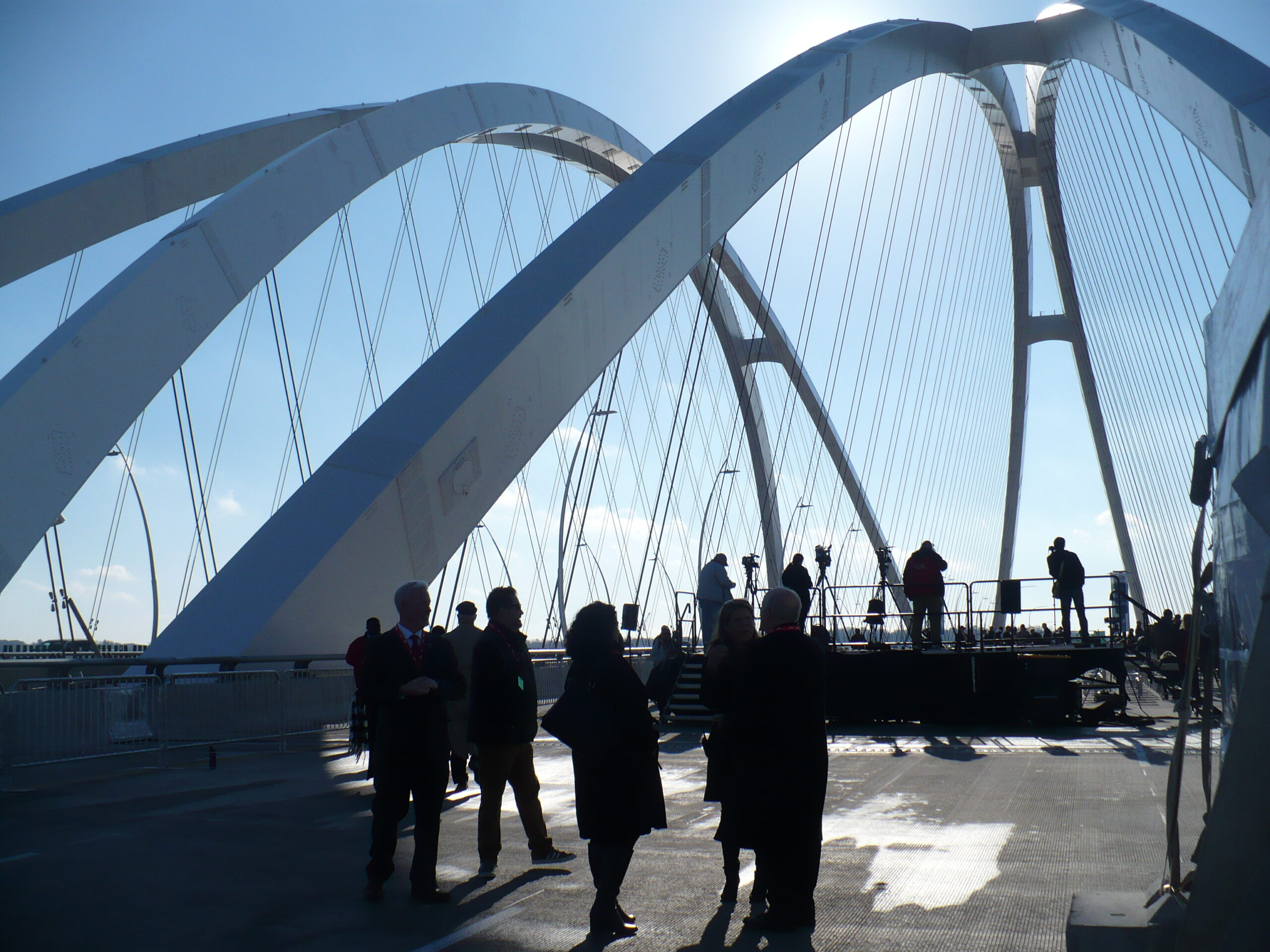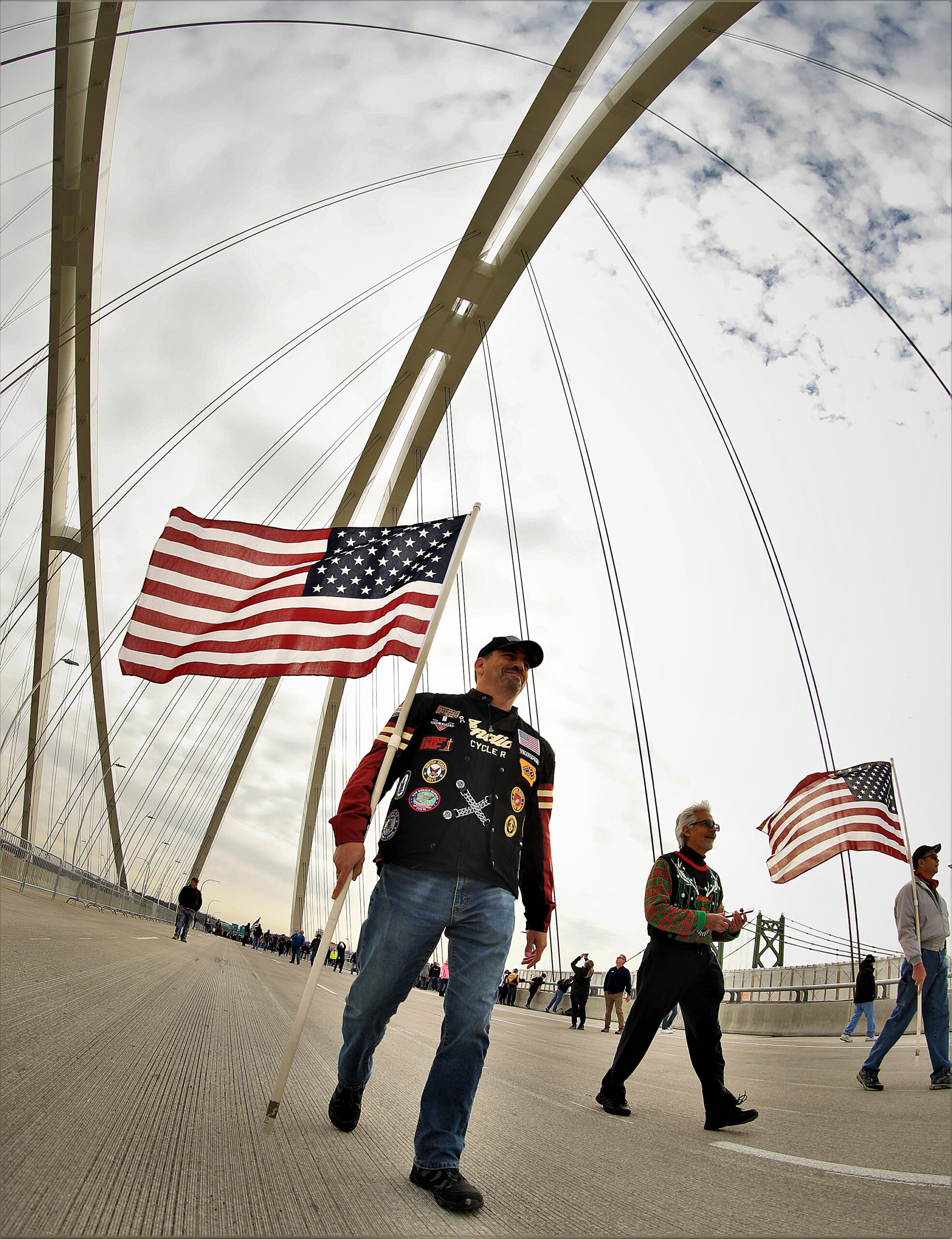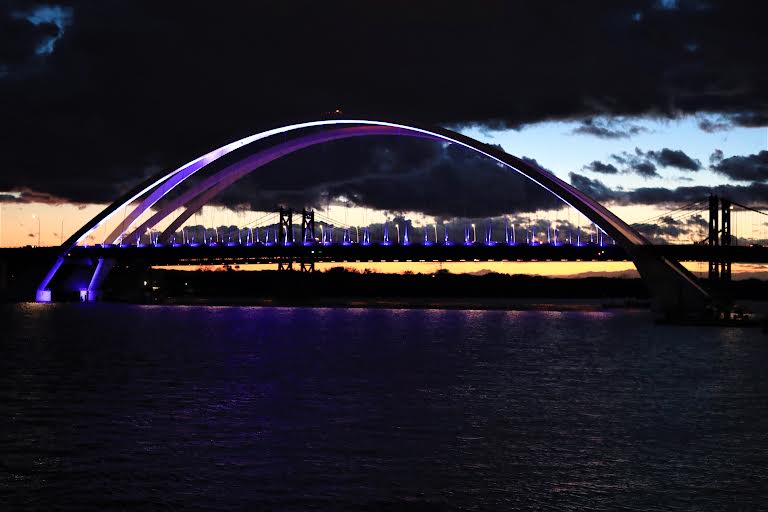
Hundreds of the men and women whose efforts led to the new Interstate 74 bridge gathered Wednesday for a sun-kissed celebration atop the newest span as thousands more Quad Citians, some carrying American flags, lined up to join the party.

The community came out in droves to celebrate the completion of the new Illinois-bound span. The full day of festivities began with breakfast at the TaxSlayer Center in Moline followed by a VIP ribbon-cutting ceremony on the bridge, a public bridge walk and an afternoon reception at Waterfront Convention Center in Bettendorf.
An estimated 4,000 guests and dignitaries took advantage of a mass public invitation and an unseasonably warm and sunny December day to walk on the span before it is expected to officially open to traffic this month.

Once that happens, for motorists the new Mississippi River bridge crossing will be largely complete. Work still is underway on the 14-foot-wide bike and pedestrian path with scenic overlook. Come spring, the project will go out for bid for an elevator that will bring bicyclists and walkers to the Bettendorf bike path.
At the afternoon reception, Bettendorf Mayor Robert Gallagher recognized the contributions of Denise Bulat, executive director of Bi-State Regional Commission; George Ryan, I-74 corridor manager; the Iowa and Illinois departments of transportation (IDOT), and local engineering firms IMEG Corp. and Shive-Hattery. Paul Rumler, CEO and president of the Quad Cities Chamber of Commerce, also presented awards to the two IDOTs.
A fireworks display and a bridge lighting capped the nearly 12-hour celebration that spanned both states.
Unity, cooperation and collaboration were the central themes throughout the day as local, state and federal leaders paid tribute to all those previous community leaders who fought for nearly three decades to make the transformational project a reality.
“Today is about the people that have been working 25-30 years: the people who lobbied in D.C. talking to senators and congressmen, who worked with Bi-State (Regional Planning Commission) and the departments of transportation to make this all happen,” Scott County Supervisor Tony Knobbe said at the welcome breakfast.
Many of the current and past leaders were among those celebrating completion of the new twin spans. Among them was former state Illinois Rep. Pat Verschoore, who shared a breakfast table with former Moline Mayor Stan Leach. “It’s a great day for the State of Illinois, a great day for the Quad-Cities and a great day for Moline,” Mr. Verschoore said.
Many speakers lauded former Republican congressman Ray LaHood, who was present for the festivities. He not only famously declared the outdated and dangerous Interstate 74 bridge one of the worst in the nation decades ago but as President Obama’s transportation secretary, he signed off on the $67 million in federal dollars that made the bridge a reality.
Bi-State’s Denise Bulat said it was that grant that paid for the study which paved the way for the bridge that is standing there today.
“I am absolutely thrilled for the people of the Quad Cities,” Secretary LaHood said. He was quick to credit others, including local political leaders, Illinois Gov. Pat Quinn, Iowa Gov. Terry Branstadt and others with moving the project along. “I’m pleased to have been a small part of it,” he said.
Leaders also lauded the 450 tradesmen and women who toiled on the bridge each day for more than four years through record cold and flooding, a derecho and a global pandemic.
“The Mississippi River is one of the most iconic and important waterways in the world, and as of today, we have a brand new way to cross it. I want to thank everyone involved in making this new bridge a reality — most importantly the workers who have spent the last four years building it,” said U.S. Rep. Cheri Bustos, D-Moline.
“Ironworkers and operating engineers, laborers and cement masons and so many others are the reason we’re able to stand here today to open this beautiful new bridge. I’m so grateful for their work underwater, on the water and up in the air over the last few years to build this incredible structure that will serve the Quad Cities for decades to come.”
Brian Atkins, business manager and financial secretary for Ironworkers Local 111, said the Ironworkers were proud to be part of the project from the foundations to the rebar to the keystone of the arches. He estimated at its highest employment peak, the local had 80 to 85 ironworkers on site at a time. Over the duration, he said as many as 125 to 140 union members clocked hours on the bridge construction.
“There were a lot of moving parts over the past three and a half years and a lot of big equipment (at work). To have no fatalities is a real milestone,” Mr. Atkins said, adding that the overall injuries also were low for a project of this magnitude. “It was a lot of dangerous work and it took a lot of skilled craftsmen and women to pull it off.”
In addition to lauding those who built the bridge, Iowa and Illinois government and transportation leaders Wednesday touted the impact the new bridge will have on the community and their states.

“The I-74 River Bridge illustrates the promise of our states and the Quad Cities communities to all who travel across it. I am thrilled that this majestic bridge will be here for generations to come, helping to bring that promise to fruition,” Iowa Gov. Kim Reynolds said in a statement read during the ribbon-cutting Wednesday. She was unable to attend due to a long-planned family engagement.
In her prepared statement, Gov. Reynolds called the bridge “a vital east-west link for the Midwest. It provides exceptional opportunities to strengthen the economies of Iowa and Illinois and improve regional and global options for moving goods produced in each of our states.”

Illinois Gov. J.B. Pritzker told the crowd gathered in the middle of the Illinois-bound span “The I-74 river bridge is a testament to what is possible when we work together to build a better Midwest. These improvements will support safer and shorter commutes, connect economies across the Mississippi, and spark opportunity across the Quad Cities. I’m proud to celebrate our partnership with the Iowa Department of Transportation and thank them for their leadership.”
Iowa Department of Transportation Director Scott Marler said “This new I-74 Mississippi River Bridge will join our states and communities, will strengthen our region, and will stand tall in welcoming new hope and opportunity to the Quad Cities and beyond for many years to come.”
In 2016, transportation officials estimated that daily traffic across I-74 bridge was 74,000. By 2035, that number is expected to reach 99,900 vehicles a day.
Local leaders focused on the economic and tourism impact the bridge will make on the Quad Cities region.

“People will come from all over to visit us here,” said Bettendorf Mayor Robert Gallagher. “We can’t wait to welcome them.”
Moline Mayor Sangeetha Rayapti said the new bridge will usher in “a once-in-a-generation opportunity for downtown Moline.”
“I’m so thankful for all who came before me to set the stage for this project,” she said at the afternoon reception. “This will increase opportunities for residential development that will change what it means to live and work in the Quad Cities.”
Construction of the bridge was an economic boon to the Quad Cities even before it opened. The project drew contractors from beyond the region, who booked hotels, ate in area restaurants and spent some of their paychecks in local businesses.
“This is probably the biggest civil project, dollar-wise, and the longest in duration that we have ever worked on as a group,” said Pat Eikenberry, IMEG Corp.’s executive vice president – civil engineering and senior principal. The Rock Island-based IMEG was hired to provide construction engineering, material testing and inspection, or CE&I, services for the bridge project.
Another hometown partner on the bridge was Shive-Hattery, which is headquartered in Cedar Rapids with offices in the Quad Cities.
“Shive-Hattery is so honored to be part of this project and how it’s reshaping downtown Bettendorf and downtown Moline,” said Jennifer Bennett, president of Shive-Hattery and a Bettendorf native. “It really took a lot of collaboration to get this one done.”
Before today, “major life-changing decisions were made around this bridge,” said the Chamber’s Rumler. Because of the history of problems on the bridge, Quad-Citians routinely made daily decisions on such things as where they would shop, eat, live or work based on the Interstate 74 river crossing. “The new bridge eliminates entirely the need to do that from here on,” he added.
Rock Island Mayor Mike Thoms said “To steal a quote from my good friend, Decker Ploehn, ‘Yeah, baby! We made it!’” Mr. Ploehn, Bettendorf’s city administrator, was among those in attendance who helped lay the groundwork for the bridge more than 25 years ago.
Illinois Department of Transportation Secretary Omer Osman said, “The I-74 Bridge is yet another example of bold leadership delivering the type of improvements in infrastructure that will keep this region competitive for many, many years to come. This beautiful new structure is especially meaningful because of our partnership with Iowa and our work with federal, state and local stakeholders.”
Contributing to this report:
Kenda Burrows [email protected]
Jennifer DeWitt [email protected]
Dave Thompson [email protected]
A timeline of some of the history of the Interstate 74 bridge and key events in the new I-74 bridge project:
1935: The westbound I-74 bridge, Illinois to Iowa, opens as a toll bridge. The bridge project costs $1.46 million. The original toll was 15 cents.
1960: The eastbound bridge, Iowa to Illinois, opens. The project cost was $6.2 million.
1970: Tolls discontinued on the bridge.
1975: The twin spans merged on the bridge.
1998: Transportation studies support building a new Mississippi River bridge.
2009: The new I-74 bridge project gets federal approval to proceed after a series of public hearings to present the findings in the Draft Environmental Impact Statement and Final Environmental Impact Statement.
2012: Former U.S. Transportation Secretary Ray LaHood says the I-74 bridge is one of the worst bridges he has seen.
2012: Conceptual design for a new bridge is completed.
2016: Traffic on the bridge exceeds 74,000 vehicles a day. It is estimated traffic numbers will rise to almost 100,000 vehicles by 2035, according to traffic projects.
May 2017: Lunda Construction awarded contract to build the bridge.
June 2017: Groundbreaking ceremony held for new bridge.
July 2017: Construction begins on the new I-74 bridge.
August 2017: Foundation work begins on the bridge.
Nov. 13, 2020: Iowa-bound portion of bridge opens to traffic.
May 2021: Arch complete on Illinois-bound bridge.
July 21, 2021: Final section of arch floor installed on Illinois-bound part of bridge.
July 2021: Illinois-bound bridge structures complete in Moline.
Nov. 15, 2021: Transportation officials announce Illinois-bound bridge expected to be open to traffic in early December.
Dec. 1, 2021: Public celebration for the upcoming opening of the new I-74 bridge.
Here’s what leaders had to say about the new Interstate 74 Bridge on Wednesday, December 1:
Samuel Easterling, Dean of Engineering, Iowa State University
“This bridge is just spectacular, and I just love bridges. This is going to be a boon for the Quad Cities. It’s going to more easily move people in and out of the area.”
Scott Marler, Director, Iowa Department of Transportation
“We made it. We made it. Yes. … This is a testament of what can be accomplished when we work together.”
Tony Knobbe, Supervisor, Scott County Board of Supervisors
“Today is about the people that have been working 25-30 years: the people who lobbied in D.C. talking to senators and congressmen, who worked with Bi-State (Regional Planning Commission) and the Departments of Transportation to make this all happen.”
Mr. Knobbe, who desperately wants to get a bolt from the old bridge as a keepsake, said the day was about celebrating all the leaders — past and present — who had a hand in the bridge’s completion. The event at the Taxslayer drew many former city officials and staff, whose careers spanned the decades of planning.
Dee Bruemer, Former Scott County Administrator, former Davenport Public Works Director
“It’s everything I thought it would be when I saw the first design — and more.”” A self-proclaimed “bridge connoisseur,” she said the final design was “the one I advocated for from the very beginning.”
Omer Osman, Secretary, Illinois Department of Transportation
“We are creating a gateway … for long-term economic growth.”
“Today is just the start of great things to come,” he said of the federal infrastructure bill that was recently signed by President Biden.
Moline Mayor Sangeetha Rayapati
“This new bridge will (usher in) a once-in-a-generation opportunity for downtown Moline.”
Bettendorf Mayor Robert Gallagher
“People will come from all over to visit us here. .. We can’t wait to welcome them.”
Rock Island Mayor Mike Thoms
“To steal a quote from my good friend, Decker Ploehn, ‘Yeah, baby! We made it!’” Mr. Ploehn, Bettendorf city administrator, was among those in attendance who helped lay the groundwork for the bridge more than 25 years ago.
“(The new bridge) helps us get motivated to do bigger things.”
Ray Forsythe, Johnson County (Iowa) Special Projects Manager
Former Moline economic development director
“I was telling the I-DOT folks it doesn’t look like it did on paper — it’s even more grand.”
He recalled making nearly a dozen of the community’s lobbying trips to Washington, D.C., and meeting weekly with the Illinois Department of Transportation. “The sad part about leaving (the city) was not being here to complete all that after work.”
Jeff Nelson, CEO, MetroLINK
“It’s incredible what a community that pulls together can do.. It was not a single effort by one person, one community. Hundreds of fingers touched the project over 20-30 years.”
Thinking back on the first discussions about the bridge, he remembered “one-half the people were naysayers – it’s not going to happen. But the other half said ‘We’ll figure it out.’”
Pat Eikenberry, Executive Vice President, IMEG Corp.
“This is probably the biggest civil project, dollar-wise, and the longest in duration that we have ever worked on as a group.
“There were challenges but our lead engineer said the awesome part of this was with the challenges we got to work on some of the solutions… that really made us feel like part of the team.”


















